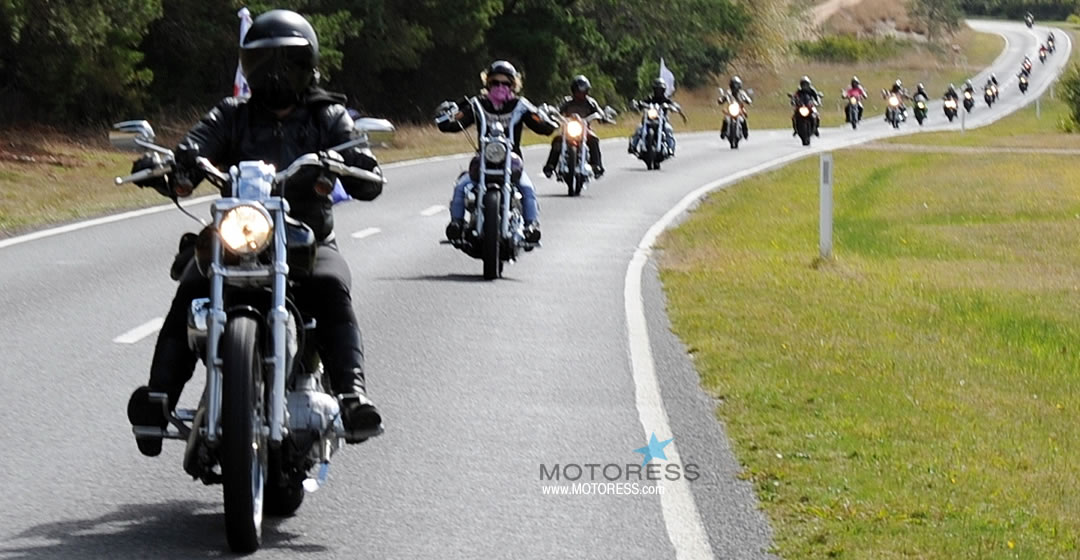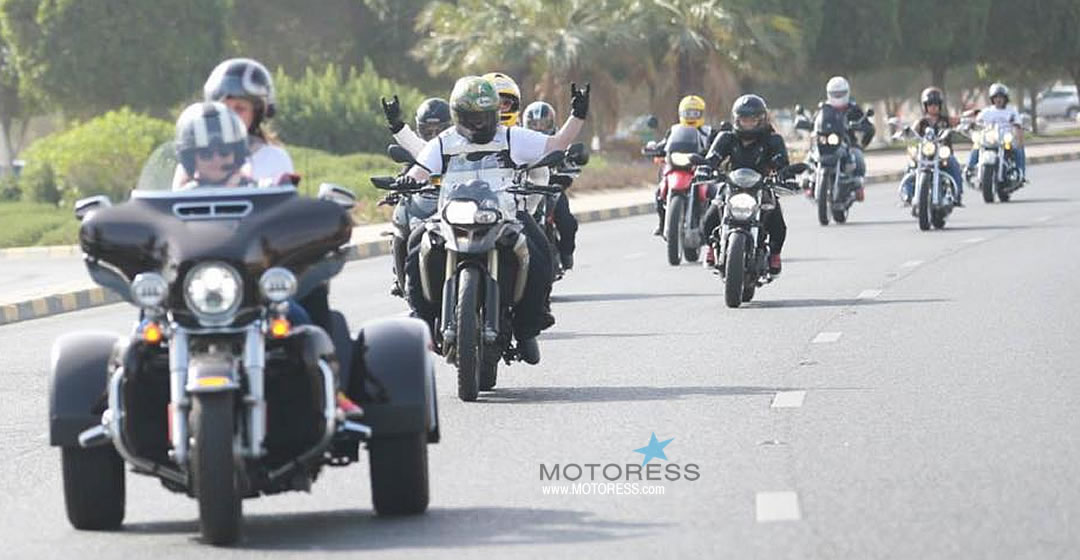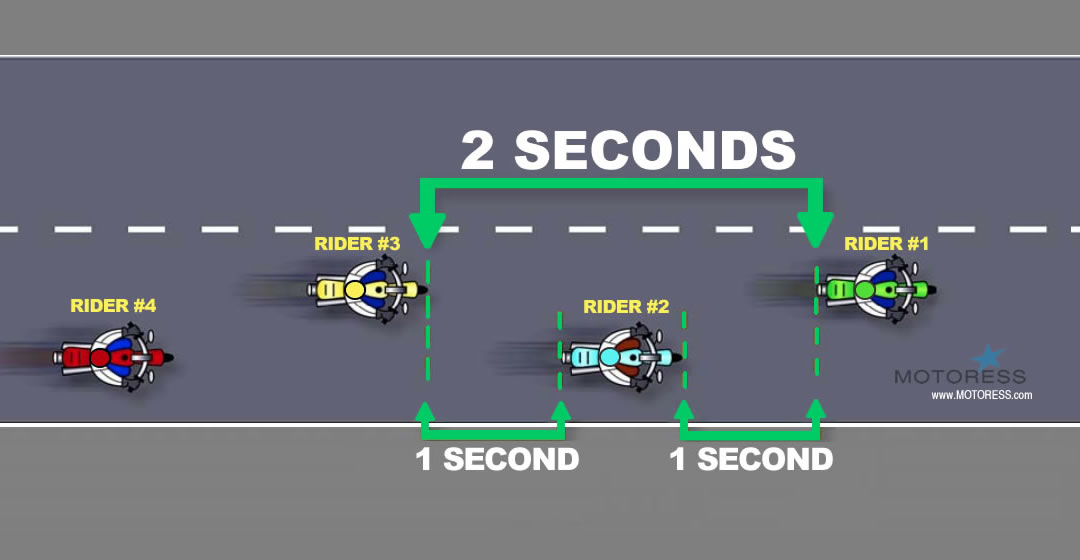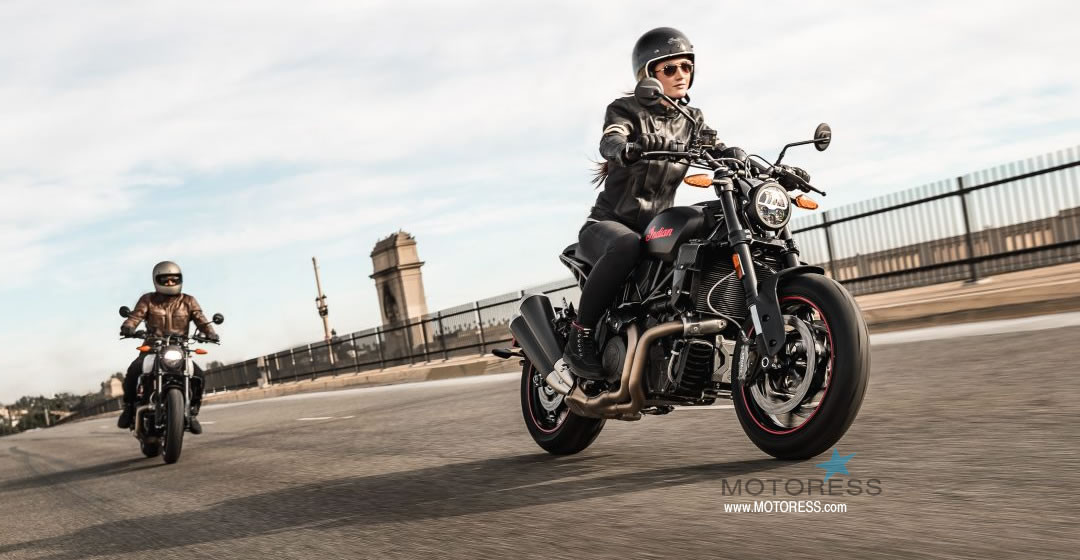Last Update: 10 April 2023
*Last Update: 28 September 2021

Enjoying a motorcycle group ride with friends is another enjoyable aspect of the motorcycle riding experience. A motorcycle group ride that’s safe and successful requires a structure all its own and the full attention of each rider. When a group ride is done correctly, it is a real pleasure resulting in a safer way to ride. In fact, a group of riders becomes a larger “object” on the road resulting in high visibility for other motorists. In a group it’s less likely an oncoming vehicle will not see you, therefore turn left in front of you, or even try to lane change into you. In fact in many cases it’s the riders within the group which pose the greatest dangers! Group riding has huge benefits when the group ride has a plan and all riders are aware of the group ride plan so read on below for the Motorcycle Rider’s Guide To Riding In A Group.
Experienced or new to riding, your first motorcycle group ride is best done with friends and riders you know well. Here you’ll get a feel for riding with motorcyclists you trust. This will ensure a great first group ride experience and enhance the experience. Equally, this will help you gain experience before participating in a group ride where you’ll be riding with riders you don’t know. Plus, as riding in a group demands extra concentration from you, with riders you trust you’ll be able to finesses this form of skill set.
Also realise that riding in a group does not relieve you or any rider of the responsibility to apply good judgement. Nor does it place the responsibility for your individual safety to that of the group leader – the group participants.
Before you participate in a motorcycle group ride, use these methods and pointers listed here to ensure a fully successful ride – start to finish!
Motorcycle Rider’s Guide to Group Riding – Arrive Prepared
The day before the ride, make a thorough pre-ride inspection your motorcycle. Equally inspect your riding gear. It is best to arrive to any group ride with a full tank of fuel. This you can do the evening before or the day of the group ride. Do a “motorcycle pre-ride inspection” the day of the group ride as well. Your safety and the safety of others in a group ride includes the mechanical heath of your ride. .
Mandatory Pre-Ride Riders Meeting
Be sure to have a motorcycle group ride – riders meeting – ahead of time to set the ground rules, in-group behaviours, and route for your ride. This is mandatory, even if you’re going to ride with one other rider. Discuss topics such as the route, rest and fuel stops and such actions if one rider has a mechanical issue. The riders meeting should be done by someone with group riding experience and/or is usually the group ride leader.
Assign a Lead and Sweep (Tail) Rider
Assigning a lead rider and a “sweep” rider at the back of the group is key to everyone’s pleasure and safety. Both these riders should be experienced riders and are experienced in group riding procedures. The leader should be aware of each rider’s skill level before the ride and monitor the riders during the ride. Usually this is the rider with posses the best riding skills and is a trusted judge of road safety. As the saying goes, “Good skills are irrelevant in the absence of good judgement!” so be sure the group leader of the ride you are joining in on is someone you have faith in.

Keep the group to a manageable size, ideally five to seven riders. If necessary, break the group into smaller sub-groups, separated by a few seconds, each with a lead and sweep rider.
Ride prepared. At least one rider in each group should posses and carry a first-aid kit, a essential tool kit, and all riders should carry a smartphone so the group is prepared for any problem that they might encounter.
A lead rider must be able to set a pace that every one in the group can follow; safely ride within a speed limit that is comfortable for all riders behind. This rider must also be able to plan ahead and communicate to the other members of the group. Making last-minute turns, stops, lane changes, etc. will catch other riders off guard and can lead to disaster. Additionally, when a rider is lost or gone amiss, it’s the group leader that will stop the group safely and ride back to find the missing rider.
YOU are entirely responsible for your own behaviour in all circumstances during the group ride.
The “sweep” or “chase rider” has the duty to keep an eye on the riders riding in front of them. If something were to happen (a fall, mechanical failure, etc.) the chase rider will be there to deal with the situation. The assigned chase rider should also be knowledgeable about the ride route.
Lost Rider
As soon as a rider is missing, the group immediately stops, unless another arrangement has been agreed upon. To continue riding would add more space between the group and the lost rider. Stopping can be done anywhere by executing a proper and safe “roadside stop”.
Motorcycle Group Riding Following Distance(s)
It is important to keep your distance from the rider ahead and beside you in order to allow for safety manoeuvres. The two second following rule is used here and enforced to the rider immediately in front of you. If the rider ahead of you suddenly detects an obstacle requiring a swerve or stop the spacing following distance rule will reduce instances of riders colliding with each other. Often riders in a group follow too close to each other- more so than they would do in other circumstances. This obviously does not allow room for error. Furthermore, it important not to follow too far behind which can create a gap in the group inviting other vehicles to enter and invade the group space.

Staggered Formation Except in Corners
Formation for riding in groups is staggered. This is where each following rider rides on the opposite lane “tire track” from the rider in front (right or left of centre). This allows space for each rider to manoeuvre left or right within their lane and permits maximum visibility for each rider ahead and/or behind. While cornering however, each rider selects their own line (often a group appears to be going single file) through the corner. So keep in mind that when approaching a corner you’ll see changes in rider “tire track” positions while manoeuvring the corner.
Social Riding Skills
Aim to ride smoother than you would normally. When you brake [before a corner or turn], accelerate or decelerate, the riders behind you will be instantly effected. In fact sudden braking on your behalf can cause a panic reaction to the rider behind you who may not have the skills to manage the reaction. Try also to keep the same speed through corners as your speed on the straightaway – keeping your speed comfortable and enjoyable for the riders behind you.
Overtaking
Passing or overtaking is done individually. The group should not try to pass together (unless the ride leaders and sweepers have a specific highway passing procedure – and some groups do). It is important not to follow the rider ahead of you blindly! If you lose the group, they will wait for you or pull over ahead. Only overtake when *you* are able to see that it’s possible. This requires patience on your part! When you become separated form the group and you see your friends riding further and further ahead of you it’s only natural anxiety creeps in. Keep calm. Additionally, each rider should spend as little time as possible making the passing manoeuvre and back into the group for safety.
Take care not to get too tired. It happens more easily than when riding alone or with people you know closely because you are constantly watching the movements of the others. Equally, don’t make the mistake of relying on others to think for you. Often in a group there’s a sense of protection as those around you sort out the dangers, roads and traffic situations for you.
Stay alert as you never know even within your group when you may have a situation.
Stay aware. And should it be that you are not happy with the riders you are riding with, remove yourself from the group.
Group Riding In Extremely Slow Situations
When riding in a group and happen to end up in traffic, amidst a group of vehicles which cannot maintain the posted speed of the road, do not travel in staggered formation. Ride in single file and, when necessary, as close as possible to the right-hand curb or edge of the roadway. Ensure the “two-second rule” which gives a minimum following distance. If you are travelling in a very large group, break into several smaller groups in order to allow faster traffic to pass.

Recap + More Motorcycle Group Riding Tips
- Identify the Ride Captain / group leader(s) to all riders and have them wear a reflective vest (High Visibility vest, arm band, etc.)
- Have novice riders in the group put a large “X” on their back with contrasting tape to warn experienced riders to be more patient and cautious around them. They may also wish to wear a different coloured vest from the lead riders.
- Divide the large group of riders into several smaller groups. Have them leave at staggered times to the same destination. This will be less intimidating to novice riders and safer for other road users as well.
- No passing within the group/ lane.
- All riders are responsible for making sure their motorcycles are mechanically up to the task. Before you even meet up with the group, make sure you’ve plenty of fuel in the tank, and that you’ve taken care of all those maintenance issues. And, you really don’t want to be the reason for stopping the group for something mechanical you could have prevented.
- Ride only in a staggered formation.
- If the goal of the ride is to keep the group together, the leader should only go at the pace of the least-experienced rider.
- Show and standardise a few basic hand signals for “slow down”, “debris on the road”, etc. Just remember, these instructions are given by lead riders only. You won’t avoid having riders remove their hands or feet from controls.
- While riding, avoid “target fixating” on the motorcycle in front of you. Instead, remember your basic training which is that of looking beyond and well through turns and corners ; look where you want to go.
- If the group is riding faster than you are comfortable with, let the sweep rider know you’re dropping out and ride at your own pace. You might reach the destination a few minutes behind the others, but you will get there, and that’s what’s important. Keep in mind, it’s all about fun.
- As turns get sharper, or as visibility decreases, move back to a single file formation. You’ll also want to use single file when entering or exiting a highway, at toll booths, or when roads have a rough or questionable surface.
- At intersections where you’ve come to a stop, tighten the formation and move beside each other to take up less space. As the light turns green, or when traffic opens up, the group proceeds one by one, returning to staggered formation.
- Circulate maps, route planners on your smartphone for online access to your destination before the ride starts. In the event that riders get lost or separated, they can still find the destination at their own pace.
- Ensure that lead riders are experienced and know where they are going. They should also know how many motorcycles are in their group and which rider will take up the last rider role in that group- prior to departure.
- Consider having the last riders in the group as the more skilled and experienced riders with novice riders mixed together to keep their speeds and skill levels more equal.
- Have each rider wait for the rider behind them at intersections where there is a direction change. If a rider has fallen back out of sight, they may miss the turn.
- Three-wheelers and sidecars should stay in the centre of the lane, and should be given the same amount of cushion as if they were a four-wheeled vehicle.
- Consider some basic helmet “Rider to Rider Communicators” for long-term club purchase and use for group rides by the “lead and sweeper” riders.
- In advance appoint a “Ride Emergency Contact Person” for the day of the ride. This way, family members know how to get in contact with someone participating in the group ride in case of family emergencies. This contact person closely monitors cell phone at all times the day of the ride.
- When parking, try to get the group off the roadway as quickly as possible. If you can, arrange in advance to have pull-through parking at your destination, or at the very least, make sure there is ample parking for your size group.
- If you are an organised riders club consider seeking legal advice about where the Club stands when you sanction a large club ride and assumed liability for when accidents (i.e. club insurance for rides, etc.) occur.
- Remember that riding in a group does not mean you surrender any decision-making when it comes to your safety. Ride your own ride, and don’t go any faster than you feel comfortable going.
Riding in a group is not only about being visible, but it’s also about working together as a team regardless if you are a group of two or twenty – communication is key. Using communications systems or smartphone connectivity are an advantage. However a simple agreement between all riders for the use of hand signals works ideally.
Remember too, if you happen to join a group of riders where no base guidelines or base rules have been established, insist on this conversation before you depart the ride. Without a “group ride” plan or discussion, you’ll open yourself and the group participants up for unsafe, unexpected and potential reckless behaviours.
Enjoy the ride!
Vicki Gray – Ministry of Ontario Motorcycle Examiner, Instructor and Race Instructor.




1 comment
Thanks, good read